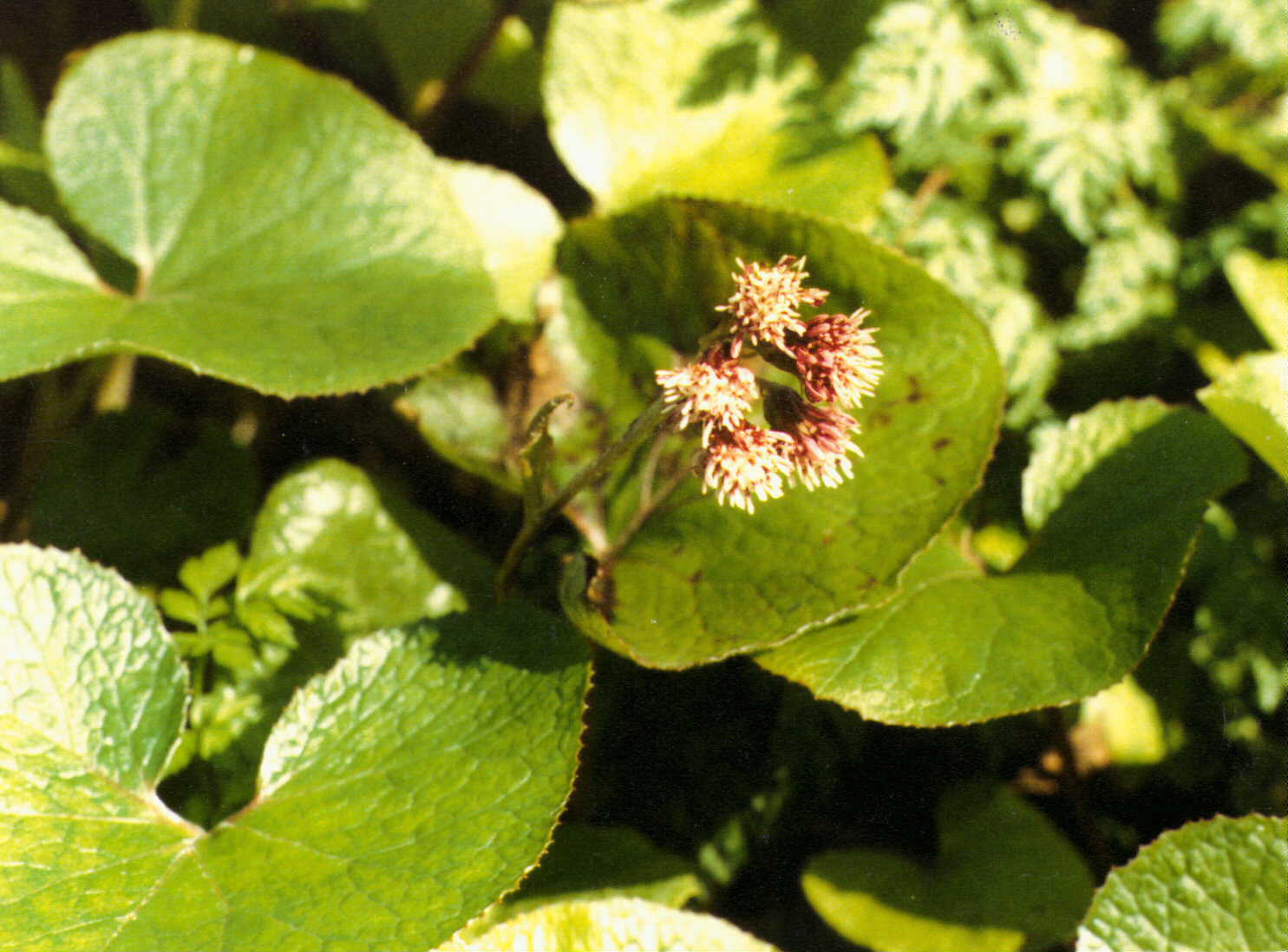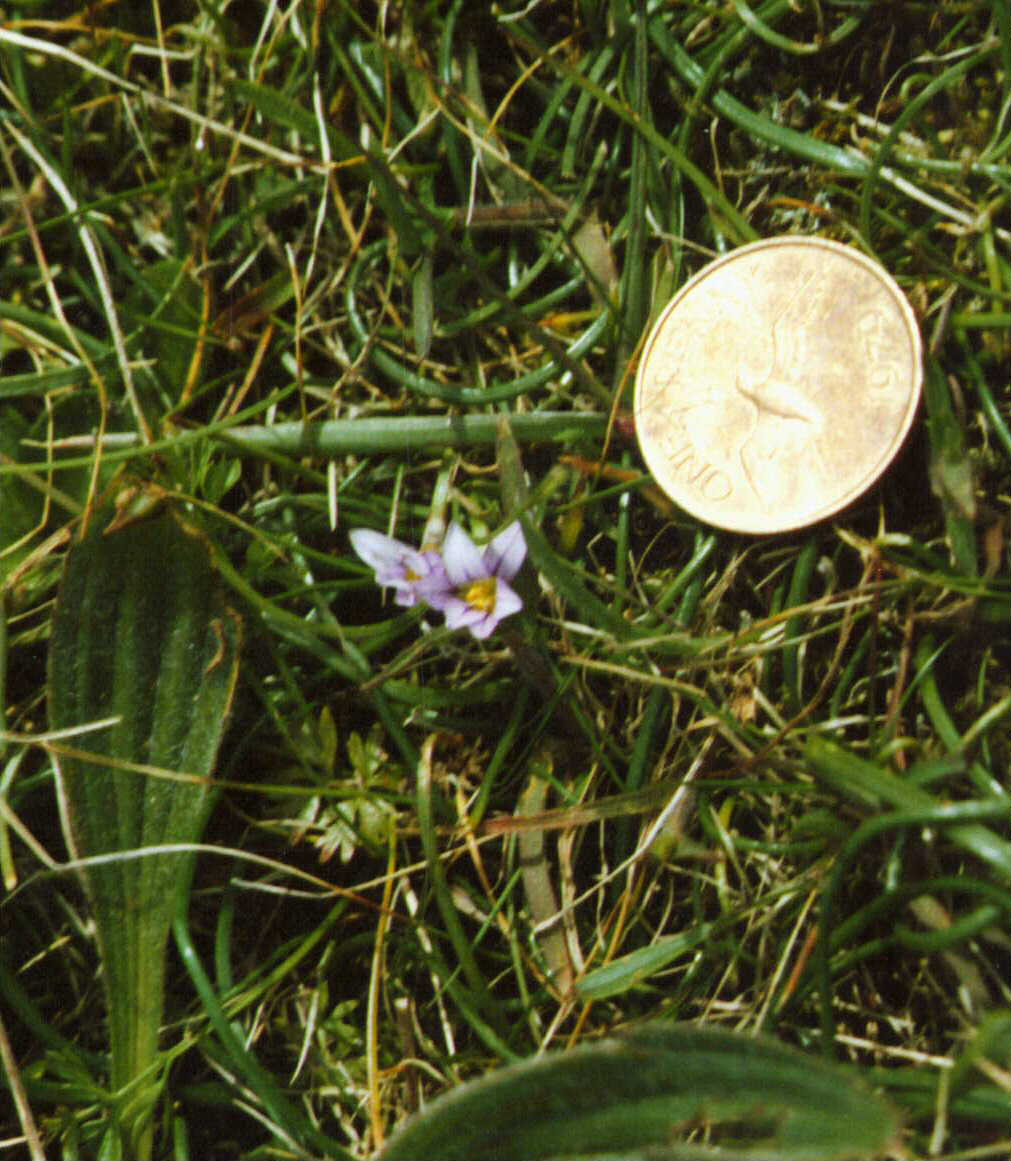
Alderney Nature Diary
April 2001
The Weather
Full moon on 7th. Moon was so bright on 10th that it recorded 0.01 hrs sun on the recorder at 23.13.
Although there was only one day with no sunshine recorded and the total for the month was slightly above last year, it was still 22 hours below average and the total for the year to date was about 50 hours down on both last year and the 20-year average.
Rainfall was slightly above the average for April, but little more than half that of 2000. On the other hand the total for the year to date was more than double last year's and almost double the 20-year average. There was an almost dry week in the middle of the month.
Maximum temperature for the month was recorded on the 1st, about 2º below average, but coldest and average temperatures were about normal for April.
Winds were mainly SW in the first and fourth weeks, but swinging right round the compass several times, between 11th and 20th with cold winds from the N-NE on alternate days. Maximum wind speed was 10 knots below last year, but other readings were similar, as were the humidity readings, which remained high at Platte Saline throughout the month.
Figures for comparison with April last year and the 20 year average
| Year | 2001 | 2000 | 20-year average |
| 1981-2000 | |||
| Rain mm. | 59.8 | 95 | 52.0 |
| Sun hrs. | 162.9 | 154.8 | 184.0 |
| Max. temp recorded °C | 14.6 | 16.8 | 16.0 |
| Min. temp recorded | 3.6 | 3.2 | 3.1 |
| Mean day temp | 10.3 | 10.3 | 11.1 |
| Mean night temp | 9.7 | 9.4 | 9.4 |
| Total rainfall, year to date, mm. | 455.0 | 204.3 | 231.2 |
| Total sunshine, year to date, hrs. | 397.1 | 458.5 | 445.0 |
The Diary
April 1st. A walk along the East coast on this sunny afternoon showed our Sand Crocus (Romulea columnae) in full flower on the headland in front of 'Tides' and a profusion of some other small, or even minute, flowers blooming in the short turf and trodden paths; Early Forget-me-not (Myosotis ramosissima), Common Whitlow-grass (Erophila verna), Common Dog-violet (Viola riviniana), with three of the Mouse-ear species (Cerastium diffusum, C. semidecandrum & C. glomeratum) amongst the longer grass. On this same headland the small,

Sand Crocus
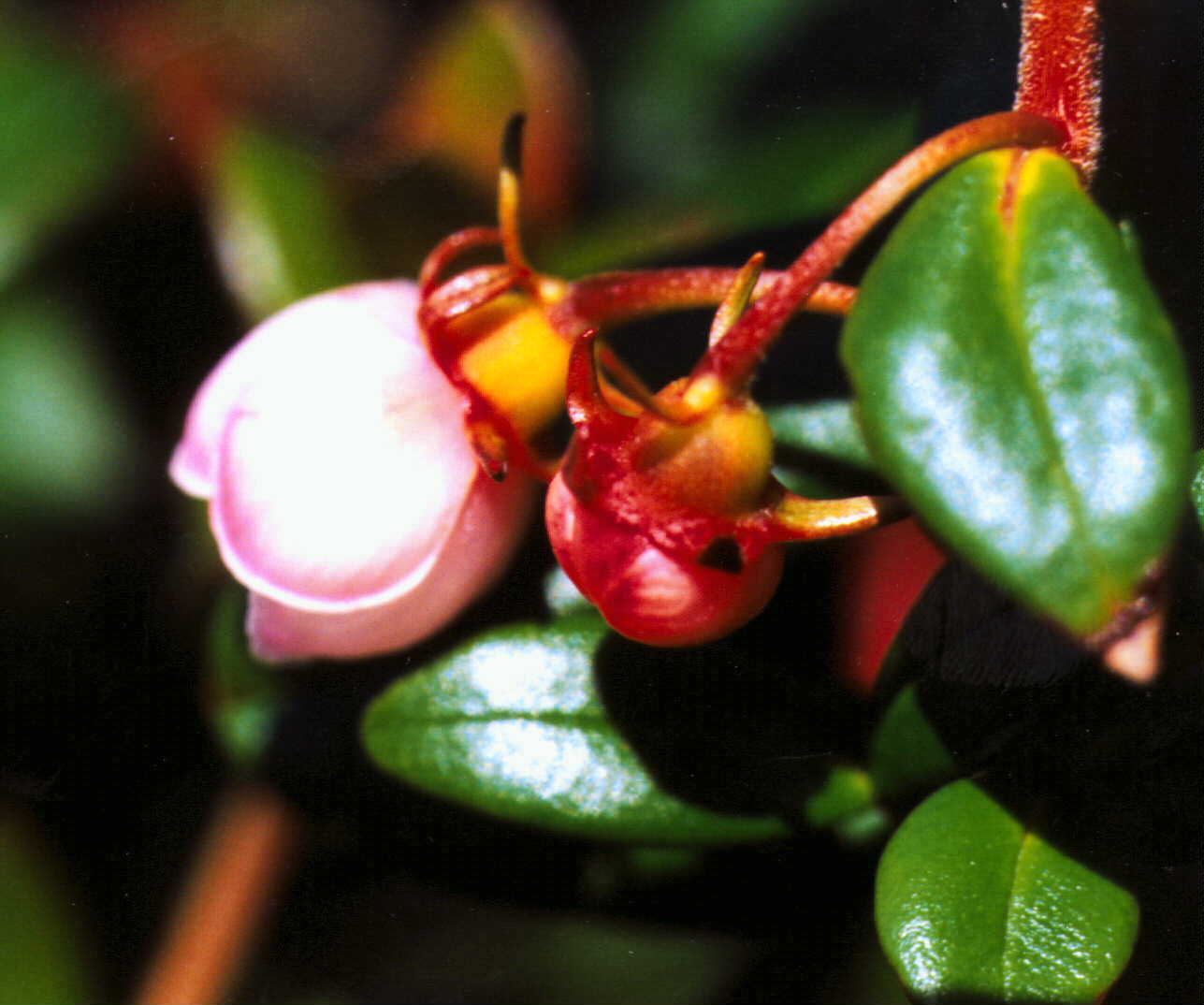
Myrtle
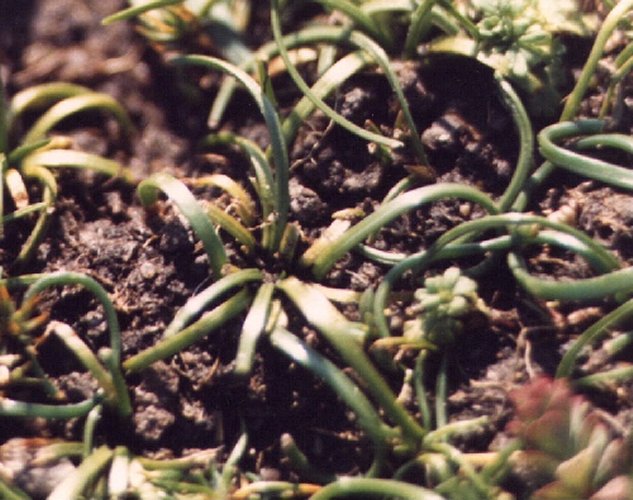
Land Quillwort
.........................................................................
rare Myrtle shrub (Myrtus ugni), growing out from under a rock had branched considerably with a mass of new shoots and three seedlings within about a metre. Bluebells were spread all round the area with a single clump of white ones noted. Danish Scurvy-grass (Cochlearia danica), was in great quantity among rocks along the edges of the beach and on walls, whilst the endangered species Land Quillwort (Isoetes histrix), one of our most primitive flowering plants, a member of the Lycopodium group was in profusion in two of its three known colonies along the stretch between here and Fort Quesnard. Lambs Lettuce (Valerianella carinata or locusta), the species are very difficult to separate unless the seeds can be examined, was coming into flower. This is widely scattered across much of the island and frequent on dry walls and bare sandy spots.
In the splash zone of the rocks near Fort Houmet Herbé, both our species of Sea-lavender, Limonium normannicum the Alderney S-l and L. binervosum Rock S-l were present in some quantity, but it will be some time before they flower. In the same small area I found only about five or six young plants of Sea Aster (Aster tripolium), very rare in Alderney, where this is its only known site and a small number of plants even then. Along the path nearby and more or less hidden under the old bracken litter, the large leaves of another infrequent plant, Cyclamen (C. hederifolium), an autumn flowering species, were seen in several large patches.
By the Lighthouse, white Sea Campion (Silene uniflora) Bulbous Buttercup (Ranunculus bulbosus), also in great quantity in most grassy patches round the island, and a large quantity of Spring Starflower (Tristagma uniflorum) had this year once again forced a path for its delicate leaves and flower stalks, through the asphalte along the bottom of a roadside wall in Route des Mielles. The other colony in a dry stone wall at Fort Essex was also in bloom.
3rd. April. A Mallard duck with 13 newly hatched ducklings on Platte Saline Pond, currently after all the rain in the last 6 months extended to the largest area of water anyone can ever remember seeing here, even the old pre-war residents. In the six months between October 1st 2000 and the end of March we have had 844mm. The last 20-year average total for a whole year has been 730mm. The first Cow Parsley (Anthriscus sylvestris) of the year was flowering in La Vallée, as was the large Horse Chestnut (Aesculus hippocastanum) by the Albert Gate in Victoria Street and those on Essex Hill.
4th. April. Clumps of Borage flowering in many verges and grassy banks, with a big patch on the Golf Course near the Simon's Place houses and a huge patch about 20m square in a plot of waste ground in Courtil Liage at the edge of Le Grand Blaye. Braye Meadow was a complete carpet of yellow buttercups in the bright sunshine. This was mown only three days ago and the flowers have already turned it yellow again. Clumps of Teasels (Dipsacus fullonum), not yet in flower, were noted in the two fields near La Blanche Fontaine and at "Windy Corner".
5th. April. More primroses than usual are flowering on the bank
 as you go up Essex Hill. There do seem to be more this year than we generally see all round, in many small, and often isolated clumps, on walls, banks and verges in several parts of the island. Let us hope it is increasing at long last. Barren Strawberry (Potentilla sterilis), photo on right, was also noted in flower, about 6 plants almost hidden by the grass, Stinking Onion leaves, ferns and Ivy on the Essex Hill bank. I have a feeling that this little plant is probably much under-recorded, it is so easy to miss under the other vegetation.
as you go up Essex Hill. There do seem to be more this year than we generally see all round, in many small, and often isolated clumps, on walls, banks and verges in several parts of the island. Let us hope it is increasing at long last. Barren Strawberry (Potentilla sterilis), photo on right, was also noted in flower, about 6 plants almost hidden by the grass, Stinking Onion leaves, ferns and Ivy on the Essex Hill bank. I have a feeling that this little plant is probably much under-recorded, it is so easy to miss under the other vegetation.
Bluebells, all three types, several small patches of the darker, more delicate native (Hyacinthoides non-scripta) with fewer florets in a drooping head, the robust, larger upright heads of the alien Spanish plant (H. hispanica) in a huge spread on top of the hill by the Fort with other scattered smaller patches, and the several intermediate hybrid forms, which, since they have arisen naturally in the island by the crossing and back-crossing of the native and alien species, must also be considered 'native'. Bluebells are everywhere this year in vast q
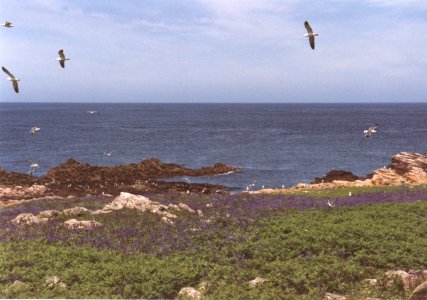 uantity. Bluebells normally form a dense understory, in the damp retaining leaf litter of old established, broad-leafed woodland, their population density thins off towards the better illuminated margins of these woods and they are not common in exposed places in bright sunlight. In Alderney there is little in the way of this type of habitat and they grow in profusion in completely unsheltered spots, often on dry sandy soil and on many hedgebanks. The little offshore island of Burhou, about a mile NW of Alderney, has its central portion covered in the native species, (photo on left), forming the dominant vegetation here in the early spring, and turning the middle of the island mauve when viewed from Alderney. The bracken in the foreground of this photo has encroached considerably in the last 20 years and an attempt has been made in the last 5 years to control the spread. Burhou was noted on a map of 1572 as "an island of much fern". It is doubtful if there has ever been any woodland here in the last 25,000 years or more, since dense mixed forest covered much of northern Europe, so one wonders where they originated.
uantity. Bluebells normally form a dense understory, in the damp retaining leaf litter of old established, broad-leafed woodland, their population density thins off towards the better illuminated margins of these woods and they are not common in exposed places in bright sunlight. In Alderney there is little in the way of this type of habitat and they grow in profusion in completely unsheltered spots, often on dry sandy soil and on many hedgebanks. The little offshore island of Burhou, about a mile NW of Alderney, has its central portion covered in the native species, (photo on left), forming the dominant vegetation here in the early spring, and turning the middle of the island mauve when viewed from Alderney. The bracken in the foreground of this photo has encroached considerably in the last 20 years and an attempt has been made in the last 5 years to control the spread. Burhou was noted on a map of 1572 as "an island of much fern". It is doubtful if there has ever been any woodland here in the last 25,000 years or more, since dense mixed forest covered much of northern Europe, so one wonders where they originated.
It has also been an exceptionally good year for many varieties of Daffodil and Jonquil. although some have been planted by the States in the last few years the majority are in places where they are unlikely to have been planted and would seem to be the self-sown remnants of the 1950-60's flower crops. Perhaps the extra wet has helped them all to appear much more luxuriant.
Celandines (Ranunculus ficaria), Common Dog-violet and Cow Parsley are frequent in the verges up the hill and especially on top of the hill where the gorse was mown off a couple of years ago. More Primroses and Bluebells around the site of the old wireless station hut, but not as many primroses as in some years, this usally being the largest site for them. Thrift (Armeria maritima), now flowering, especially along the cliff edges and in the shorter turf, with the usual patches of Honesty (Lunaria annua), near the old water tank and the gatehouse of the Fort. Sand Crocus flowering in the narrow trodden paths leading to the cliff edge on the southern side of the hill and a few tiny plants of Shepherd's Cress (Teesdalia nudicaulis), in the bare rocky parts of the cliff. Heath Woodrush (Luzula campestris), known locally as Good Friday Grass (photo on right), is coming into flower just when it should, however early or late Easter may be.
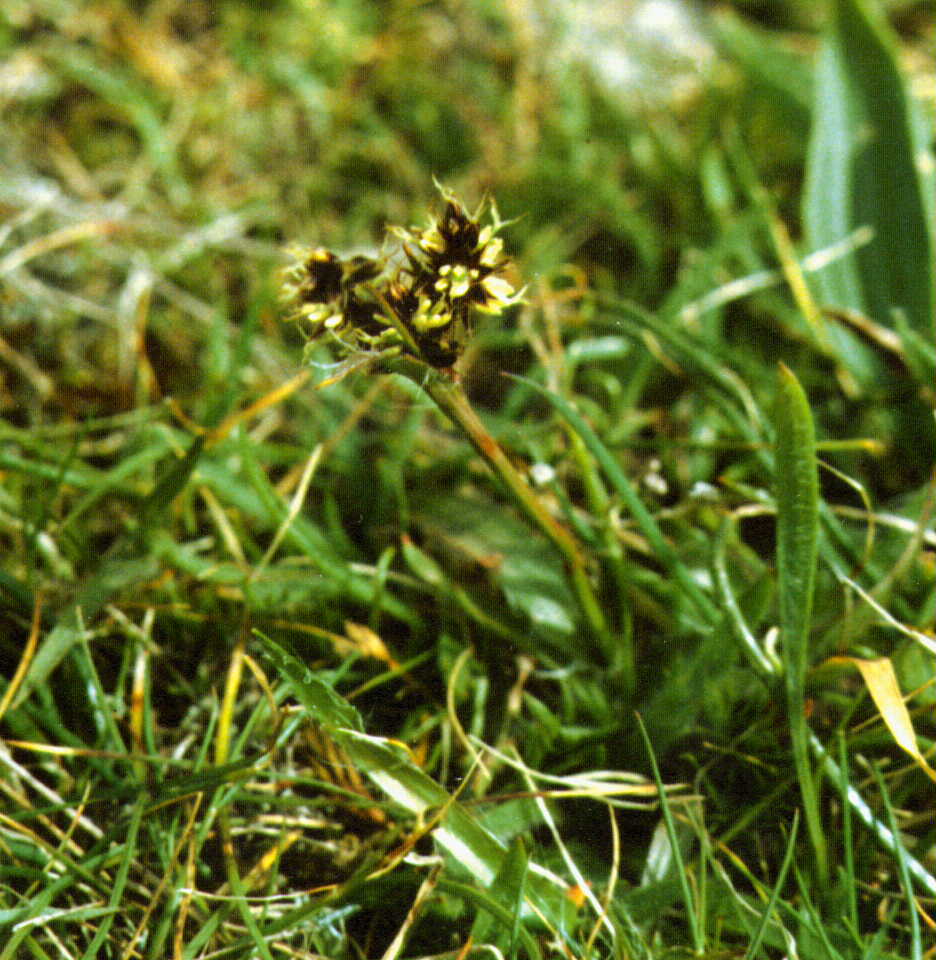
Pink Campion (Silene X hampeana), is now coming into flower on many banks, verges and waste places.
9th April. Cow Parsley now in profusion all round the island, the delicate, finely cut leaves and nodding white heads on comparatively slender stems truly deserving one of its folk names, "Queen Anne's Lace". Danish Scurvy-grass in full flower along many inland roadside edges and wall bottoms as well as close to the sea. We don't use any salt on our roads in winter, there is rarely any need anyway, so one wonders what encourages this to grow inland. Blackthorn (Prunus spinosa), and the apparently sterile hybrid (P. x fruticans), are just coming into flower. The square plantation of about 100 small trees along Le Grand Val, near Rose Farm is always covered in blossom but I have never found a single fruit there. Greater Periwinkle (Vinca major), is present in small quantity along several roadsides, in the rough bramble/bracken scrub at a number of places, presumably a "garden escape", but often a long way from any houses. I have examined the flowers of many of the plants but it always seems to be this species and never the Lesser Periwinkle.
The many large patches of Gorse are now opening their brilliant yellow flowers and the foliage will be totally obscured by them in a week or two. Thrift and Sea Campion are now flowering widely, again in many cases, a considerable distance from the coasts and cliffs. The several Mouse-ear species are common everywhere and Sweet Alison (Lobularia maritima), is once again clothing many banks, verges and walls with its mass of small round flower heads. There are few weeks in the year when this is not in flower somewhere in the island. The whole island now seems white with 'Stinking Onions', Three-cornered Garlic (Allium triquetum). There is talk about removing this from our "Mauvaises Herbes" law as it is impossible to eradicate and, although it would need to be discouraged on farmland in the interests of good husbandry, which was the original intent in 1952 of adding it to the 1933 law, it is a nuisance rather than a danger and there is little agricultural cultivation today anyway. It is hard to believe that in 1901 it was recorded by Marquand in his Flora of Guernsey and the Lesser Channel Islands as; "a small patch about 5 yards square on the NW side of Fort Tourgis and nowhere else in the island. Also in grassy places in Victoria Street, at Government House and in St. Anne's Churchyard. In these last stations perhaps planted".
Patches of the white-veined leaves of Italian Lords and Ladies (Arum italicum), are appearing in many places, as well as in their denser numbers in The Terrace and other damp sheltered spots, where they are usually mixed with the all-green-leaved form. It will be several weeks yet before these flower. Amongst these on a bank in Bluestone Hill about a dozen plants of Grape Hyacinth (Muscari racemosum), are flowering, another site for a "garden escape" which must already have been there for some years. A large patch of Periwinkle here, stretches well back into the Hawthorn scrub between the Golf course and the road at this point. Dove's-foot Crane'sbill (Geranium molle), is in profusion on banks, commons, in lawns and other grassy places. The size of both plant and flowers varies greatly according to the site, being almost minute in short well-trodden turf and lawns and up to about 30cm high on damp banks. Sea Radish (Raphanus raphanistrum subsp. maritimum), in both white and yellow-flowered forms is now in flower in many places. Hairy Onion (Allium subhirsutum), rare in Alderney about 20 plants in flower near the Lighthouse, one of its few regular spots.
The wet weather has finally refilled the reserve reservoir in Corblets Quarry to a point half way up the window openings of the old hut, the point where it used to be, prior to being almost emptied in the 1986/87 drought. As there is only a very small spring in the floor of the quarry this is almost entirely the result of rainfall. I estimated at the time, that it would take 8-10 years to refill and, apparently with some degree of pumping to the main reservoir in the interval it has actually taken 14 years to refill to that level.
Hoary Stock (Matthiola incana), is now flowering all round the island, a few plants in some places, many in others. The mauve form is much more frequent with the white form most common around the Corblets area, especially on the inner walls of the quarry, and in The Cut near the harbour. The Wild Pear (Pyrus pyraster), clinging to the top of the quarry wall on the seaward side of York Hill Quarry, the only specimen in the island as far as I know, is now in flower. The whole tree (more nearly a bush) is very much wind-shaped to keep the majority of the bush below the quarry rim, sheltered from the N-NW winds. Lamb's Lettuce, Danish Scurvy-grass and Herb Robert are now frequent in many places.
Viewed from Clonque Bay the Gannet Rocks (Les Etacs and Ortac) are all covered in white, from both the densely packed birds and their droppings. Gannets can be seen all day, circling the rocks and flying in small skeins to and from their fishing grounds. At Les Etacs, when viewed from the Giffoine, there are many more nests on the smaller rocks forming the group this year. On the slopes above the bay and around Fort Tourgis the Gorse flowers are well behind those at the eastern end of the island. Common Dog-violet is frequent in the grass along the edges of the track and in the shorter turf on the slopes, Celandines do not seem to be so plentiful here this year. The winter storms and the continuous rain have caused a considerable number of falls of soil and 'head' from the low cliff here, to the beach below. One has completely buried the long established colony of Water-Cress (Rorippa nasturtium-aquaticum).
11th April. The Stinking Onions are in full flower at last all round the island. In more sheltered spots such as La Vallée and Le Petit Val, the garlic smell is very strong indeed. Bluebells on banks and open spaces everywhere now.
12th April. Four young Rabbits grazing in the field behind Robin Rock, several other seen in various places in the next few days. Primroses on several banks where I have not noted them in previous years. Perhaps the wet winter has helped their spread/recovery. The clump of Iris hollandica, possible relic of an horticultural crop from the 1960s, growing in the field hedge opposite my gate has 8 blooms on it this year.
13th April. Platte Saline pond is now the biggest I have ever seen it, stretching almost out to the road. Larger also than in the living memory of any locally born people, even from before the war, when no water was being extracted from the Bonne Terre stream, as it is today, now forming our principal source of domestic water.
15th April. Small clump of Primroses noted in the grass verge near the Power Station.
17th April. The several, well-established patches of Snow-in-Summer (Cerastium tomentosum), and all the commoner small Cerastiums are now in flower all round the island.
18th April. The first Cuckoo I have heard this year, calling above Bonne Terre. A whole family of baby rabbits on one of the tees of the Golf Course. Swallows hawking on Longis common, also the first I have seen this year. within the next few days they were present in hundreds swooping over many open spots, especially fly-catching above the pools of standing water spread over the common and the road still being flooded across. A pair of Mallard in one of these and a pair of Moorhens in another. The whole area within about 4-500m of the Lighthouse is covered in Bluebells, varying in colour from the dark mauve of the native species, to pale blue, white and even a clump of pink, of the Spanish variety and the hybrids.
The Hawthorn blossom is now opening all round the island and by the end of the month the trees and bushes were so densely white that the leaves were totally obscured on some of the large specimens. The pink blossom on other May trees has yet to open and the closely related Pear-fruited Cockspur-thorn (Crataegus pedicillata), in the Old Churchyard has barely started to open its leaves.
23rd April. St George's Day, but no sign of the St. George's Flies yet this year. The yellow Wallflowers (Erysimum cheiri), on top of the high walls in Les Mouriaux are flowering and many clumps of Pink-sorrel (Oxalis articulata), are in flower in verges and on banks around t
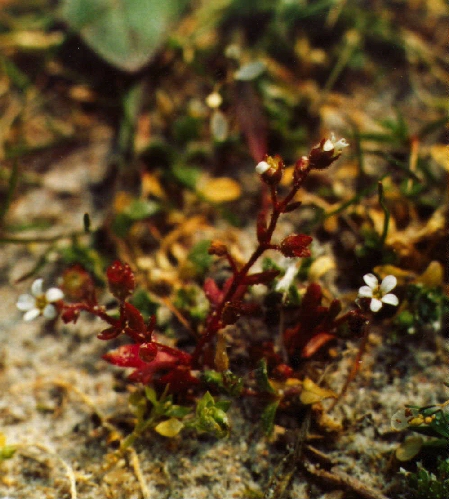 he island. Very pale Pink Campion (Silene x hampeana), and plenty of yellow Wild and Sea Radish (Raphanus raphanistrum subspecies raphanistrum & maritimum), in many places. The latter subspecies also having many white-flowered plants, especially on Longis Common and along the east coast. Tiny red plants of Three-fingered Saxifrage (Saxifraga tridactylites, photo on left), occur in small patches in both these places with both white and mauve-flowered plants of Field Madder (Sherardia arvensis), and several of the small Mouse-Ear's (Cerastium semidecandrum, C. diffusum, & C. glomeratum), much more frequent. The rosettes of Dwarf Thistle (Cirsium acaule), at its only site along the east coast seem to have spread somewhat since last year, with a few small plants of Carline Thistle (Carlina vulgaris), scattered along the edge of the grassy bank above the beach along this stretch, neither yet anywhere near the flowering stage. A few tiny plants of Ladies Fingers (Anthyllis vulneraria), are already flowering, before they ar
he island. Very pale Pink Campion (Silene x hampeana), and plenty of yellow Wild and Sea Radish (Raphanus raphanistrum subspecies raphanistrum & maritimum), in many places. The latter subspecies also having many white-flowered plants, especially on Longis Common and along the east coast. Tiny red plants of Three-fingered Saxifrage (Saxifraga tridactylites, photo on left), occur in small patches in both these places with both white and mauve-flowered plants of Field Madder (Sherardia arvensis), and several of the small Mouse-Ear's (Cerastium semidecandrum, C. diffusum, & C. glomeratum), much more frequent. The rosettes of Dwarf Thistle (Cirsium acaule), at its only site along the east coast seem to have spread somewhat since last year, with a few small plants of Carline Thistle (Carlina vulgaris), scattered along the edge of the grassy bank above the beach along this stretch, neither yet anywhere near the flowering stage. A few tiny plants of Ladies Fingers (Anthyllis vulneraria), are already flowering, before they ar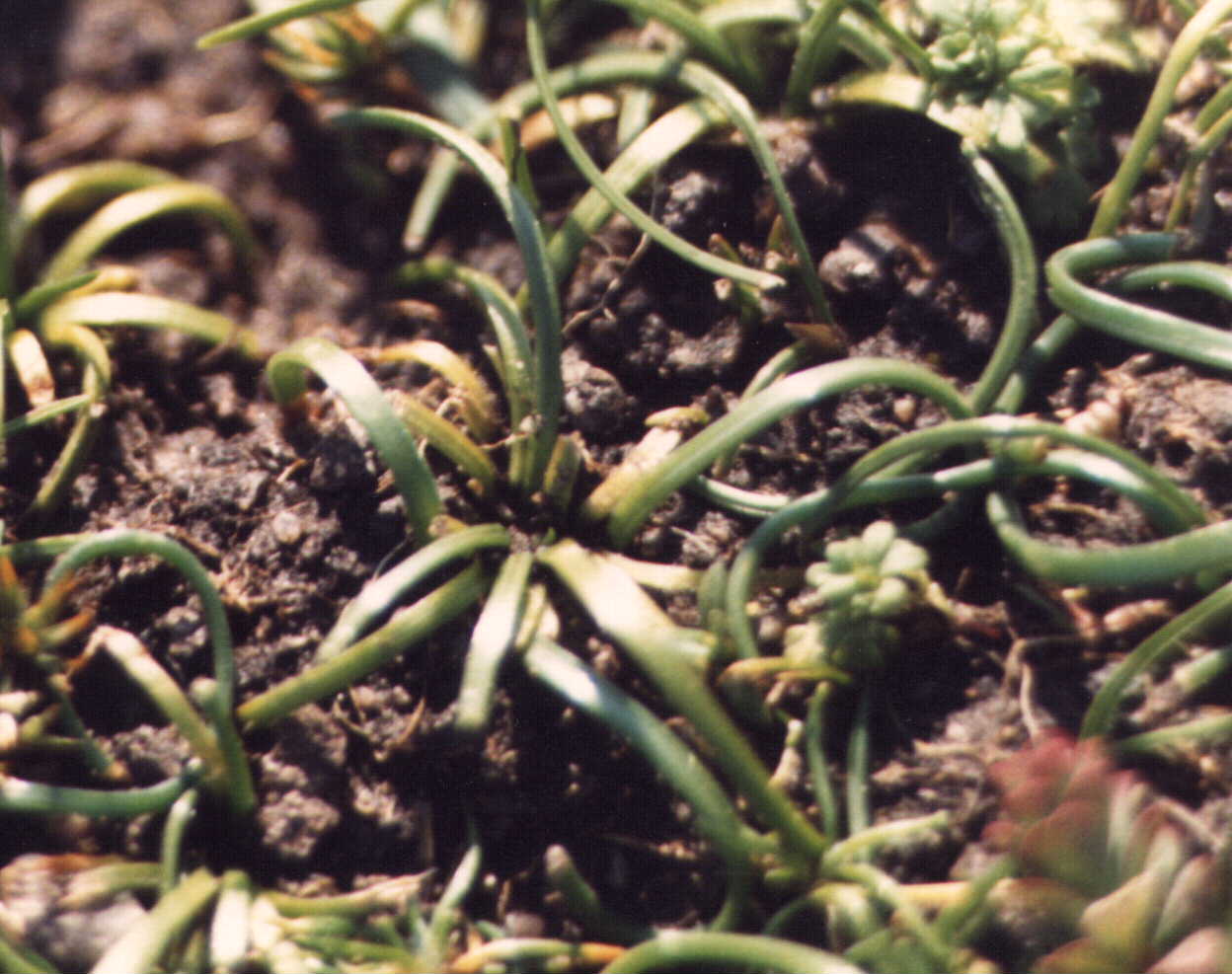 e more than a handspan across.
e more than a handspan across.
The rosettes of Land Quillwort are now showing in their thousands in the usual sites here, but I searched in vain for it in the almost identical habitat, (flooded in winter, dry sandy ground in summer), behind the outcrop of rocks just E. of Vau Trembliers. It has never been found at this spot, but I wondered if anyone had ever actually looked for it here before.
In short turf along the coast, on Longis Common, around Berry's Quarry and on Mannez Hill, small numbers of Common Whitlow-grass were still flowering. At the Berry's Quarry site and along the east coast, small patches of the furry, silvery-grey leaves and short runners of Shaggy Mouse-ear-hawkweed (Pilosella peleteriana), were in evidence.
2 5th April. The "St. Peter Port Daisies" (Erigeron karvinskianus, photo on left), more properly known as Mexican Fleabane, are flowering all over my garden, widely self sown from a single plant I brought from Guernsey in 1987, but still very rare on walls in Alderney.
5th April. The "St. Peter Port Daisies" (Erigeron karvinskianus, photo on left), more properly known as Mexican Fleabane, are flowering all over my garden, widely self sown from a single plant I brought from Guernsey in 1987, but still very rare on walls in Alderney.
27th April. The buds on the Indian Chestnut (Aesculus indica), in Connaught Square are just beginning to break. The flowers will not appear until early June, 5-6 weeks at least later than the common Horse Chestnut. Pink, puce and yellow flowers are now showing on the many patches of Hottentot Fig (Carpobrotus edulis), at Platte Saline, in Newtown Road, along the east coast, etc. Again, it will be several weeks before these are so covered in bloom as to almost obscure the foliage.
28th April. A Wall butterfly in the garden, First I have seen this year. Several Wheatears flying along the Fort Albert glacis and over Longis Common. Hoary Stock (Matthiola incana), both white and mauve forms in full flower in several places and the odd plant in verges, on waste ground and on banks. Those on the cliff walls surrounding Corblets Quarry pond are, as usual, all white. I have never seen the generally more common mauve variety at this particular place and the two forms never seem to hybridise. The single Wild Pear (Pyrus communis), in Mannez Quarry is just showing a small amount of blossom. The small patch of Green Alkanet (Pentaglottis sempervirens), on some waste land near Quesnard is flowering too. This is only the second place in Alderney where I have ever recorded this particular species. Here the mass of Bluebells surrounding it all seem to be the Spanish variety or hybrids.
Longis Common is flooded again after another 20mm rain in the last 3 days, with water pouring across the road for about 100m or more.
At the other end of the island a large area of Navelwort (Umbilicus rupestris), is just coming into flower by the Tourgis Dolmen. Along the track below the fort, round Clonque Bay, Buttercups, Daisies, Stinking Onions, Thrift and Celandines, make a colourful carpet. The low cliff between the track and the beach has been badly eroded all the way along by the constant rain and the storms of the winter and spring. Tightly packed layers of coarse, sharp-edged 'head' rock is projecting from the soil face of the bank. Fresh water is seeping from the cliff face in several places and a nice clump of Common Scurvy-grass (Cochlearia officinalis), not very "Common" in Alderney is showing about half way along to the Clonque cottages growing in a patch of grass which has slipped down, about a metre above the beach level.
It is my impression that the wet weather has been of considerable help to the numbers and brilliance of the Bluebells this year and I have rarely seen so many Primroses, generally an uncommon sight in Alderney. On the other hand, the Three-cornered Garlic ('Stinking Onions') is flowering much later than usual and there was very little blossom on the Winter Heliotrope (Petasites fragrans) this year. 